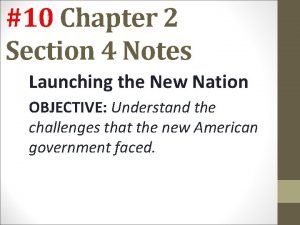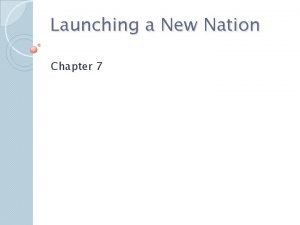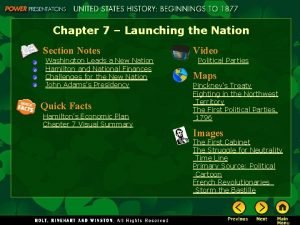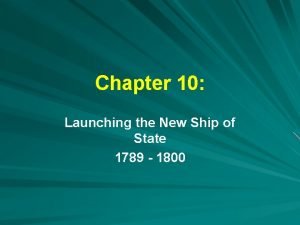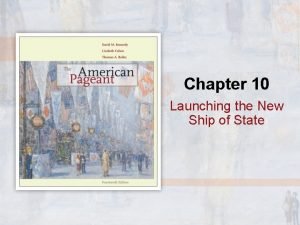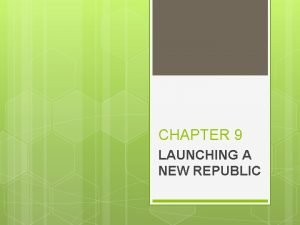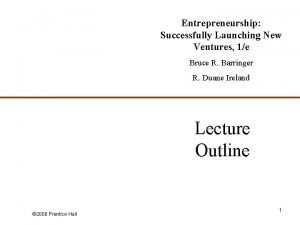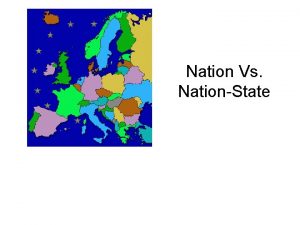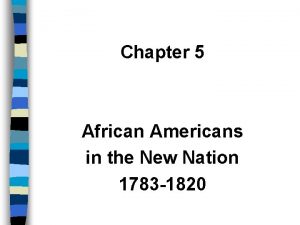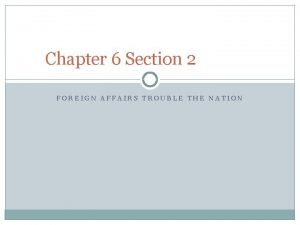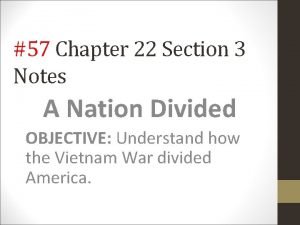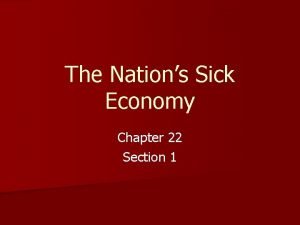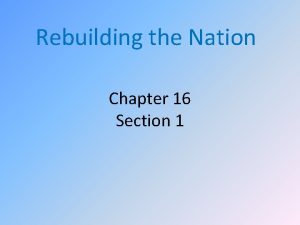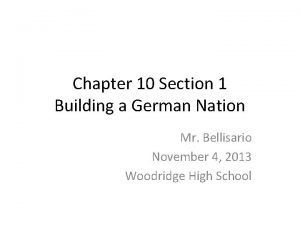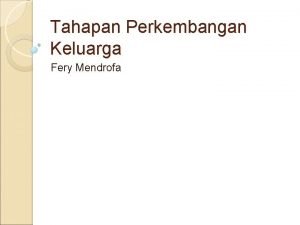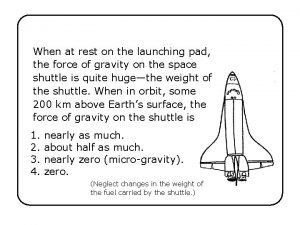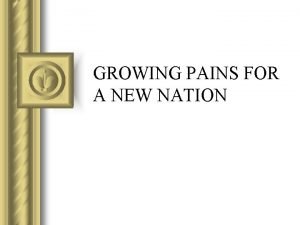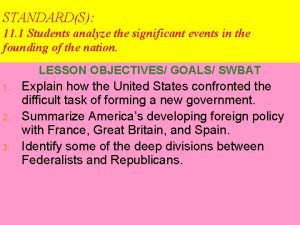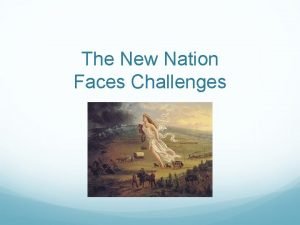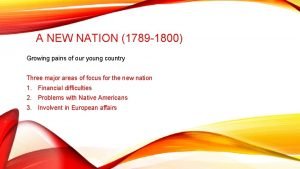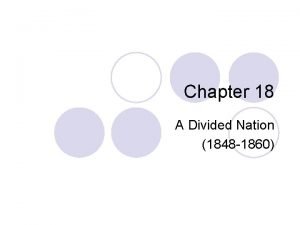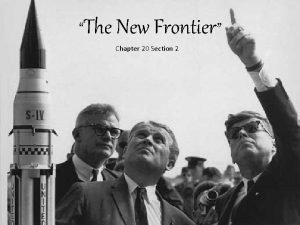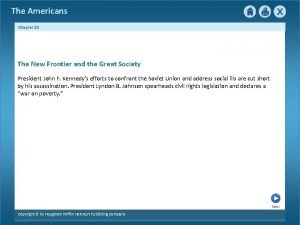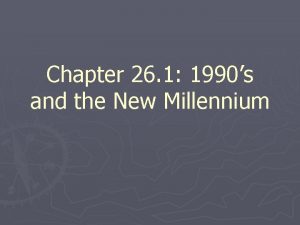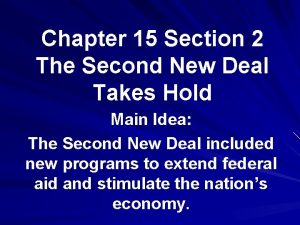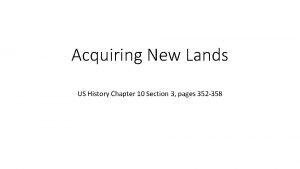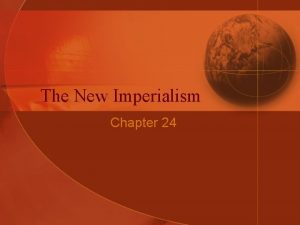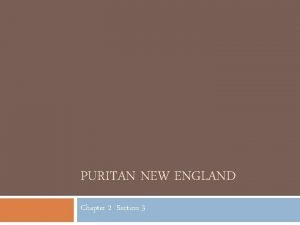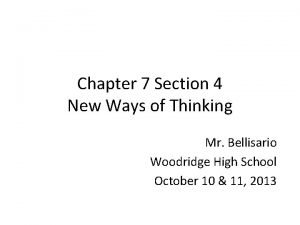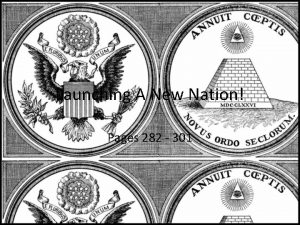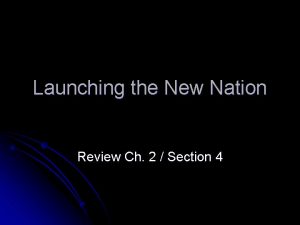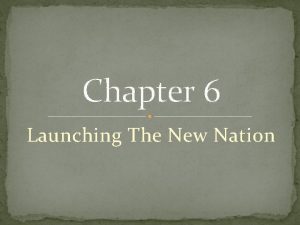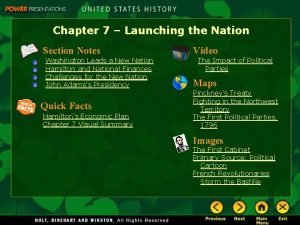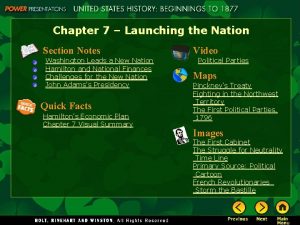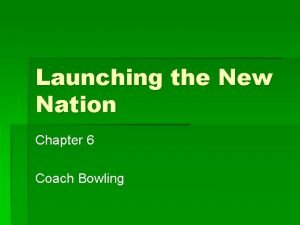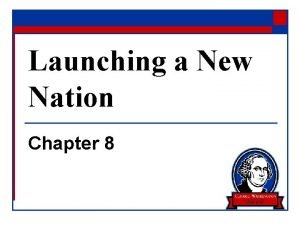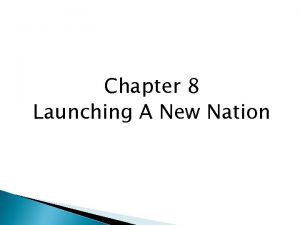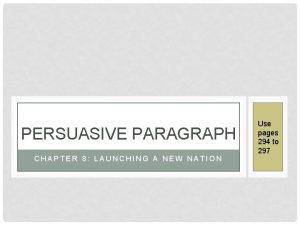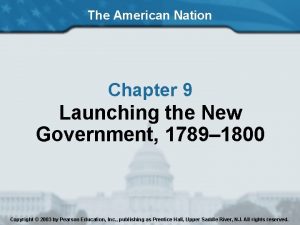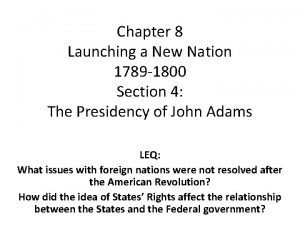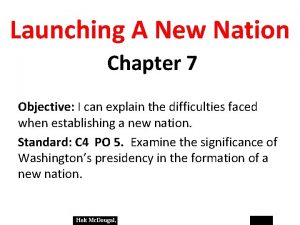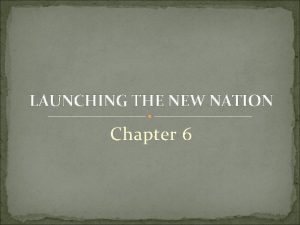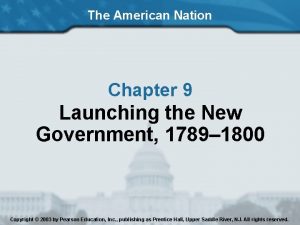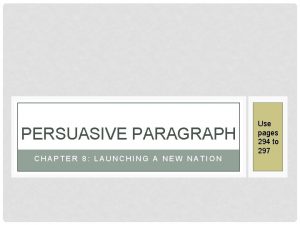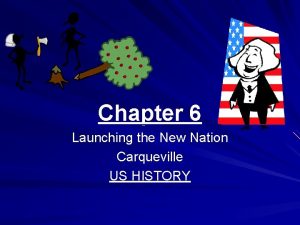Chapter 10 Launching a New Nation Section 1








































- Slides: 40

Chapter 10 Launching a New Nation

Section 1 -Laying the Foundations of Government • The First President • Even though George Washington had plans to retire after the Constitution was ratified, his colleagues has other plans. • In January 1789, the 11 states that had passed the Constitution sent electors to choose the first president. These delegates formed the electoral college. Each Legislature had chosen electors that were based on state population and state popular vote. • On April 6, 1789, George Washington won the presidency won unanimously. He chose John Adams as his vicepresident. • His wife, Martha Washington, brought much respect to the office as well.

Life in the New Republic • In 1790 the United States was home to almost 4 million people. • Most lived on farms and in the countryside. • Only 2 cities had a population of 25, 000 or more people; New York City and Philadelphia.

Setting Precedents • “The first of everything in our situation will serve to establish a precedent. ” Letter written from George Washington to James Madison about the new federal government • A precedent is an action or a decision that serves as an example for later generations. • Planning the Executive Branch was the first precedent to set. He selected certain people to serve as his department heads, or those who oversaw different affairs.

Washington’s department heads • Secretary of the Treasury-Alexander Hamilton • Secretary of State-Thomas Jefferson

The Judiciary Act of 1789 • It created a federal court system with three levels. – The District Court was the lowest level court – The Court of Appeals was the next level up. It reviewed cases that were made in the District Courts. – The Supreme Court was the highest level court. It had six justices at first, but today has nine. – The President nominates all candidates for federal judgeships. He does, however, need Congressional approval. – John Jay was the first chief justice appointed to the Supreme Court.

The U. S. District Courts and Courts of Appeals

Section 2 -Hamilton and National Finances • Alexander Hamilton – Grew up on the island of Nevis in the British West Indies – Helped his father run a shipping company there as a teenager. – He was sent to America by his friends and family for an education because they saw how intelligent and hard working he was. – He eventually married into a very wealthy New York family and began practicing law.

Paying off national debt • This was Hamilton’s biggest challenge • The U. S. owed $11. 7 million dollars to other countries such as France. • National debt is money owed by the United States to its lenders. • The U. S. also owed about $40. 4 million to its citizens. Most of this debt was in the form of bonds, or certificates that represent money owed. These bonds are sold during the war to raise money to pay for the war with the promise to pay the money back, with interest, after the war was over. Many businesses saw this as a way to make a profit. • Some people sold their bonds for less than their original value to speculators. Speculators are people who buy items at low prices in hopes that the value will rise.

Paying off the state debt • The States owed $25 million in Revolutionary War expenses. • Hamilton wanted the Federal Government to pay for $21. 5 million of this debt. The idea was to create support and trust in the federal government. • Some states like Virginia and North Carolina that didn’t have much war debt didn’t want help from the federal government. • Hamilton knew that he would need help from other states to pass this plan.

Moving the capital of the United States • New York was the capital up to this point because of its social, economic, and political importance. It was also the largest city in America. • Hamilton used southern officials who didn’t like the capital being in New York to gain support for his plan. Promising southerners to move the capital and offering to pay state war debts allowed the compromise to happen. • In July, 1790, Representatives met on the Potomac River to set a new site for a new capital. • The site chosen is today known as Washington D. C. .

Hamilton vs. Jefferson • Hamilton believed in a strong central government • Had little faith in the common person • Believed his approach would protect everyone’s freedom while keeping the people from having too much power. • He wanted newer forms of economic growth by promoting manufacturing and business. He wanted to hand out “prizes” to companies that showed “excellence or superiority”. • He also wanted to impose a protective tariff, a tax that would raise the prices of foreign goods. His hope was that this would cause Americans to buy American goods. • Jefferson wanted to protect the powers of the states. • He defended the people’s right to rule the country. • He feared putting too much trust in manufacturing and business. • He believed that farmers were the most independent voters. He believed that agriculture was the key. • He also wanted lower tariffs to help the farmers with cost.

The Debate over the “Bank” • Hamilton wanted a national bank where the government could safely deposit money. • The bank could also loan money to the government and to businesses. • He also wanted the bank to be able to mint or make coins. This would allow the government to begin issuing money. • He wanted to give it a 20 -year charter. After 20 years Congress could look at its effectiveness and decide whether or not to make it permanent.

Jefferson’s rebuttal • Jefferson and Madison both said the Constitution did not give Congress this power. • Jefferson fought Hamilton’s “loose construction” belief that the U. S. needed the bank. Loose construction is using the elastic clause in the Constitution to make laws that are necessary. • Jefferson felt that Hamilton was abusing the elastic clause by saying to President Washington that the clause is for laws that are necessary, not convenient. Jefferson said that the Bank was a convenience, and therefore made the elastic clause not apply. • Jefferson’s view became known as strict construction. Strict construction is the view that the federal government should do only what the Constitution specifically says it can do.

The Verdict • President Washington and Congress agreed with Hamilton. • They felt a bank would offer more security for the national economy. • In February 1791 Congress chartered the Bank of the United States. • Over the next 20 years, the Bank helped offer stability in improving the U. S. economy.

Section 3 -Troubles Ahead • The French Revolution began in July 14, 1789 when French citizens stormed the Bastille, a French fortress. • This revolution was an attempt to overthrow the French monarch. • Thomas Jefferson was the U. S. minister to France during this revolution. He stated that, “this is the first chapter of European liberty. ” • In 1793, King Louis XVI and Marie. Antoinette were beheaded.

King Louis XVI and Marie Antoinette

U. S. Neutrality • A few months after the French and England went to war, the debate over whether to get involved began. • Some wanted to repay the French with support because they helped America in the Revolutionary War. • Others wanted to stay out of it. • Washington’s own cabinet began to become divided on the issue. Washington commented on the issue, “The duty and interest of the United States require that they should with sincerity and good faith adopt and pursue a conduct friendly and unbiased towards the fighting powers. ”

The Neutrality Proclamation • This document stated that the United States would not take sides with countries at war in Europe. • Washington felt that this plan would be the safest and most reasonable. • Some disagreed with this position. Madison himself argued about Washington’s ability to make this decision without the consent of Washington.

“Citizen Genet” • Edmond Genet was France’s new representative to the United States. • He traveled around America seeking support for France’s revolution. • He found four sea captains who agreed to command privateers. Privateers are private ships allowed by a country to attack its enemies.

Jefferson leaves • With Washington’s stance on the French war, Jefferson began to become annoyed. • Jefferson felt that Hamilton’s pro-British stance was influencing Washington’s decisions. • As a result, Jefferson left Washington’s cabinet in December 1793. • Washington was disappointed, but the two maintained a high regard and respect for one another.

Jay’s Treaty • In 1793, the British began seizing American ships carrying food to the French West Indies. • The British were also encouraging American Indians to up rise against American settlers. This violated the Treaty of Paris 1783. • In response, Washington sent Chief Justice John Jay to England to work out a peaceful resolution. • The two sides reached an agreement. Jay’s Treaty did little it said it would do, but Washington felt it was the best he could do.

Pinckney’s Treaty • Out west, there was a rising dispute about the Spanish Florida and Louisiana border. • As a result of this dispute, Spain closed down the port of New Orleans. This severely hurt western merchants who relied on the goods passing through New Orleans to trade with other countries. • Washington asked U. S. ambassador Thomas Pinckney to negotiate a deal with Spain to re-open New Orleans. • He requested right of deposit at the pot of new Orleans. The right allowed American boats to transfer their goods at New Orleans without paying fees on their cargo. • Pinckney’s Treaty was a huge success.

Section 4 -Challenges at Home • Joseph Brant, or Thayendanegea, rallied American Indian support against American settlers in the Ohio Valley. He formed an alliance of Indian groups that refused to buy American goods and sought a new treaty with the U. S. government to keep from being pushed off their lands.

Conflict in the Northwest Territory • Despite the protests of the American Indians, Americans continue to settle the Northwest Territory. • Miami chief Little Turtle, equipped with guns and ammunition, went to war with British traders in 1790 and managed to defeat them. • Washington sent General Anthony Wayne to the frontier to take charge of the army.

The Battle of Fallen Timbers • American Indian forces and the U. S. Army clash at the Battle of Fallen Timbers on August 20, 1794. • Wayne’s troops won decisively and then burned the Indian villages and fields. • In August 1795, Indian leaders signed the Treaty of Greenville. This treaty gave the U. S. access to American Indian lands in the Northwest Territory and guaranteed the safety of U. S. citizens there. • In exchange, the Indians received $20, 000 worth of goods and the claim to lands they still had.

The Whiskey Rebellion • More conflicts arose on the frontier when Congress passed a tax on American-made whiskey. • Farmers who couldn't pay the tax, began a rebellion known as the Whiskey Rebellion in 1794. • Protestors refused to pay the tax and even tarred and feathered the tax collectors. Some called themselves the New Sons of Liberty. • Washington sent troops into western Pennsylvania to quell the rebellion, but by that time it has already died out.

Washington’s Farewell Address • In 1796 Washington decided not to run for a third term. • He wrote he was “tired of public life” and “strongly wished for retirement”. • He also wanted to remind the American people that he was only president, not king. He wanted to remind the people that they were the true leaders. • He did worry, however, that political parties would weaken the country. He urged public unity.

Section 5 -John Adam’s Presidency • John Adams, being a two-term vice president to Washington, consulted his wife about running for president. She told him to run or quit. So he ran. • The election of 1796 began a new era in American politics. • For the first time, there were more than one candidate running for office. • There were also political parties involved with these candidates. The parties are groups that help elect a government official and shape government policies.

The Federalist Party • Despite Washington’s warnings, two political parties emerged. • The Federalist Party wanted to make the federal government stronger and to promote industry and trade. It was started with the help of Alexander Hamilton. • The Federalist Party chose vice president John Adams and South Carolinian Thomas Pinckney.

The Democratic-Republican Party • This party was started by Thomas Jefferson and James Madison. • The members of this party were called Republicans, though they are not related to today’s Republicans. • They wanted limited government. • This party chose Thomas Jefferson and New York politician Aaron Burr.

The Campaign • Both sides attacked each other. • Republicans called the Federalists the British Party. • Campaign posters for Jefferson called Adams a “Royalist”. • Adams managed to defeat Jefferson, but just narrowly. • During this time, the loser became vice president even if they were not from the same party. • So the election of 1796 left John Adams as president and Thomas Jefferson as vicepresident.

President Adams and the XYZ Affair • One of Adams first efforts as president was to strengthen the U. S. relationship with France. • He called 3 American diplomats to France to negotiate a better relationship. • The French respond by not meeting with the Americans. • Three French diplomats did however meet secretly with the Americans and demanded a $250, 000 bride. • Adams was outraged! • The story became known as the XYZ affair. The X, Y, and Z were the letters that were used in place of the 3 French diplomats names.

The Alien and Sedition Acts • As a result of the XYZ affair, Adams asked Congress to strengthen the American Navy and keep a standing army ready in case of French attack. • Some supported Adams’ decision, but others attacked him. • A fear of disloyal citizens began to spread. • In response to this fear, Federalists in Congress passed the Alien and Sedition Acts.

The USS Constitution • • To protect American merchant ships, the U. S. Navy decided to create a small navy. The USS Constitution became the most well known of this navy. Because of its toughness during battle, it earned the nickname “Old Ironsides” It remains the oldest commissioned warship afloat.

What The Acts Said • The Alien Act gave the president power to have foreign residents removed from the country. If they were believed to be “involved in any treasonable or secret plots against the government” then they could be removed from the country. • The Sedition Act stated that the U. S. citizens could not join any plots against the government’s policies. The Act also made it illegal to “write, print, utter, or publish” any false or hostile words against the government or its policies.

The Argument • These laws were applied mostly to the Republicans. • Jefferson and Madison struck back with the Kentucky and Virginia Resolutions. • These two Resolutions stated that the Alien and Sedition Acts were unconstitutional. • They asked Congress to repeal the Acts. – Congress refused – A Congress later decided not to renew them – The premise however that states could challenge a federal government law was made with these two Resolutions.

The Election of 1800 • Despite Adams’ problems he decided to run again. • Thomas Jefferson and Aaron Burr are the Republican candidates. • John Adams and Charles C. Pinckney are the opposition to Thomas Jefferson. Adams and Pinckney were in different parties

A Narrow Republican Win • Jefferson and Burr won 73 electoral votes to 65 for Adams and 64 for Pinckney. • The Problem however was that there was a tie between Jefferson and Burr. They were both eligible for president. • The decision went to the House of Representatives for a vote for president. This happened 30 times with a tie every time! • Hamilton began to push for Jefferson because he trusted Jefferson more than Burr. • This helped Jefferson get elected with Burr as his vicepresident • The result of this situation led Congress to pass the Twelfth Amendment in 1803. – This created a separate ballot for president and vice president to avoid a tie in the future.

Hamilton and Burr Duel • The bitterness that came out of the election of 1800 was expressed in a dual between Alexander Hamilton and Aaron Burr. • Burr challenged Hamilton several times, and Hamilton refused several times. • Hamilton fearing being labeled a coward finally accepted the challenge, but said he would not fire upon Burr. • On the day of the dual Hamilton refused to fire upon Burr, but Burr did not hesitate and shot Alexander Hamilton died several days later from his wounds.
 Chapter 2 section 4 launching the new nation
Chapter 2 section 4 launching the new nation Launching the nation section 1 answers
Launching the nation section 1 answers Launching the nation section 1 answers
Launching the nation section 1 answers Chapter 9 launching a new republic
Chapter 9 launching a new republic Chapter 10 launching the new ship of state
Chapter 10 launching the new ship of state Chapter 10 launching the new ship of state
Chapter 10 launching the new ship of state Chapter 9 launching a new republic
Chapter 9 launching a new republic Entrepreneurship successfully launching new ventures
Entrepreneurship successfully launching new ventures Example of nation
Example of nation State vs nation
State vs nation State vs nation
State vs nation Chapter 5 african american in the new nation
Chapter 5 african american in the new nation Foreign affairs chapter 6
Foreign affairs chapter 6 Chapter 22 section 3 a nation divided
Chapter 22 section 3 a nation divided Chapter 22 section 1 the nation's sick economy
Chapter 22 section 1 the nation's sick economy Chapter 16 section 1 rebuilding the nation answer key
Chapter 16 section 1 rebuilding the nation answer key What economic changes in the 1830s promoted german unity?
What economic changes in the 1830s promoted german unity? Launching family
Launching family Tony and sue are launching yard darts
Tony and sue are launching yard darts Contoh backgrounders perusahaan
Contoh backgrounders perusahaan Projectile apparatus with impact board and launching ramp
Projectile apparatus with impact board and launching ramp Personal entrepreneurial competencies meaning
Personal entrepreneurial competencies meaning Bga safe winch launching
Bga safe winch launching Challenges faced at each stage of the family life cycle
Challenges faced at each stage of the family life cycle When at rest on the launching pad the force
When at rest on the launching pad the force Launching customer
Launching customer A new nation and its growing pains review
A new nation and its growing pains review Creating a new nation
Creating a new nation The new nation faces challenges
The new nation faces challenges Growing pains for the new nation
Growing pains for the new nation A divided nation section 3
A divided nation section 3 Chapter 16 toward a new heaven and a new earth
Chapter 16 toward a new heaven and a new earth Chapter 20 section 2 the new frontier
Chapter 20 section 2 the new frontier New deal affects many groups
New deal affects many groups Chapter 28 the new frontier and the great society
Chapter 28 the new frontier and the great society Chapter 26 section 1 the 1990s and the new millennium
Chapter 26 section 1 the 1990s and the new millennium The second new deal takes hold chapter 15 section 2
The second new deal takes hold chapter 15 section 2 Platt amendment significance
Platt amendment significance Chapter 24 section 5 china and the new imperialism
Chapter 24 section 5 china and the new imperialism Puritan new england chapter 2 section 3
Puritan new england chapter 2 section 3 Chapter 7 section 4 new ways of thinking
Chapter 7 section 4 new ways of thinking
